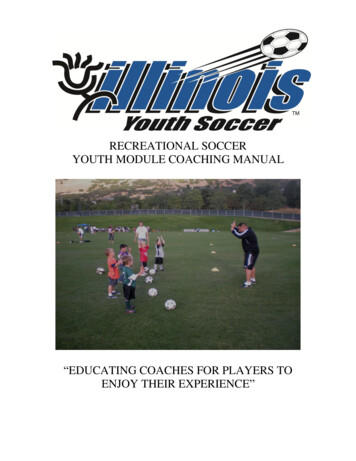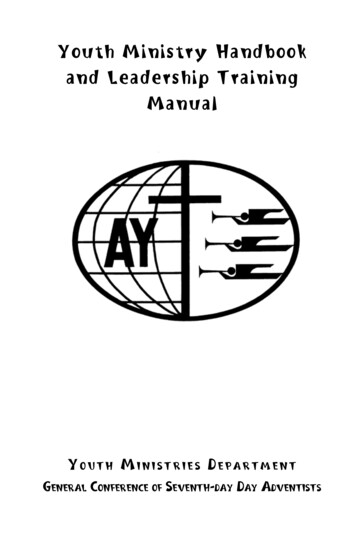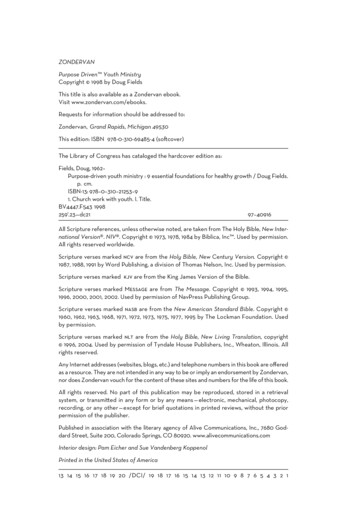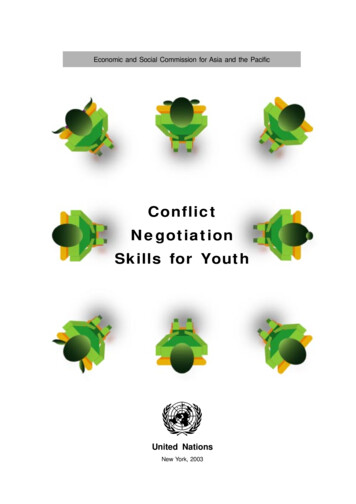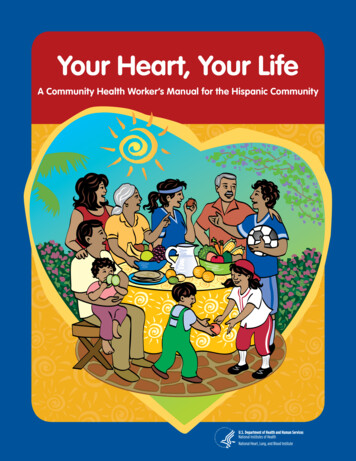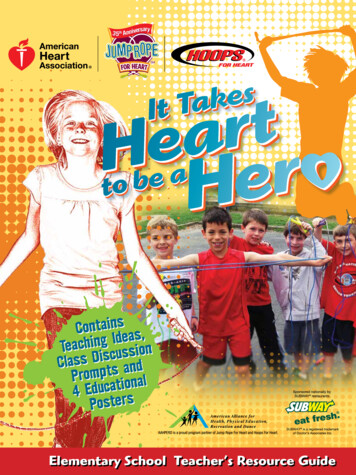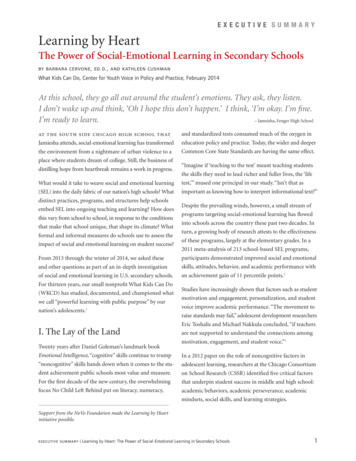
Transcription
EXECUTIVE SUMMARYLearning by HeartThe Power of Social-Emotional Learning in Secondary Schoolsby barbara cervone, ed.d., and kathleen cushmanWhat Kids Can Do, Center for Youth Voice in Policy and Practice, February 2014At this school, they go all out around the student’s emotions. They ask, they listen.I don’t wake up and think, ‘Oh I hope this don’t happen.’ I think, ‘I’m okay. I’m fine.I’m ready to learn.– Jameisha, Fenger High School Jamiesha attends, social-emotional learning has transformedthe environment from a nightmare of urban violence to aplace where students dream of college. Still, the business ofdistilling hope from heartbreak remains a work in progress.What would it take to weave social and emotional learning(SEL) into the daily fabric of our nation’s high schools? Whatdistinct practices, programs, and structures help schoolsembed SEL into ongoing teaching and learning? How doesthis vary from school to school, in response to the conditionsthat make that school unique, that shape its climate? Whatformal and informal measures do schools use to assess theimpact of social and emotional learning on student success?From 2013 through the winter of 2014, we asked theseand other questions as part of an in-depth investigationof social and emotional learning in U.S. secondary schools.For thirteen years, our small nonprofit What Kids Can Do(WKCD) has studied, documented, and championed whatwe call “powerful learning with public purpose” by ournation’s adolescents.1I. The Lay of the LandTwenty years after Daniel Goleman’s landmark bookEmotional lntelligence, “cognitive” skills continue to trump“noncognitive” skills hands down when it comes to the student achievement public schools most value and measure.For the first decade of the new century, the overwhelmingfocus No Child Left Behind put on literacy, numeracy,and standardized tests consumed much of the oxygen ineducation policy and practice. Today, the wider and deeperCommon Core State Standards are having the same effect.“Imagine if ‘teaching to the test’ meant teaching studentsthe skills they need to lead richer and fuller lives, the ‘lifetest,’” mused one principal in our study. “Isn’t that asimportant as knowing how to interpret informational text?”Despite the prevailing winds, however, a small stream ofprograms targeting social-emotional learning has flowedinto schools across the country these past two decades. Inturn, a growing body of research attests to the effectivenessof these programs, largely at the elementary grades. In a2011 meta-analysis of 213 school-based SEL programs,participants demonstrated improved social and emotionalskills, attitudes, behavior, and academic performance withan achievement gain of 11 percentile points.2Studies have increasingly shown that factors such as studentmotivation and engagement, personalization, and studentvoice improve academic performance. “The movement toraise standards may fail,” adolescent development researchersEric Toshalis and Michael Nakkula concluded, “if teachersare not supported to understand the connections amongmotivation, engagement, and student voice.”3In a 2012 paper on the role of noncognitive factors inadolescent learning, researchers at the Chicago Consortiumon School Research (CSSR) identified five critical factorsthat underpin student success in middle and high school:academic behaviors, academic perseverance, academicmindsets, social skills, and learning strategies.Support from the NoVo Foundation made the Learning by Heartinitiative possible.executive summary Learning by Heart: The Power of Social-Emotional Learning in Secondary Schools1
“School performance is a complex phenomenon, shapedby a wide variety of factors intrinsic to students and intheir external environment,” the authors noted. In addition to content knowledge and academic skills, “studentsmust develop sets of behaviors, skills, attitudes, and strategies that are crucial to academic performance in theirclasses, but that may not be reflected in their scores oncognitive tests.” 4In back-to-back commentary pieces in Education Week inJanuary 2013, education thought leaders David T. Conleyand Mike Rose called, respectively, for rethinking the notionsof “noncognitive” and “cognition.” Conley suggestedreplacing the term “noncognitive” with “metacognitive”:the mind’s ability to reflect on how effectively it is handling the learning process as it is doing so.5 Rose suggestedreclaiming the full meaning of cognition—“one that isrobust and intellectual, intimately connected to characterand social development, and directed toward the creationof a better world.”6Paul Tough’s talk of “grit” in his popular book How ChildrenSucceed gives muscle to the “soft” qualities traditionallyattributed to character skills. And long-overdue nationalattention to the deleterious effects of “zero tolerance”policies has recently elevated another strand of SEL:replacing punitive discipline with restorative practices thatheal rather than harm.We sense that educational thinking and practice is at acusp, ready to turn away from a dichotomous view oflearning and toward a more capacious view that appreciates the complex interplay between academic and socialemotional skills.II. What We Saw and HeardIn the course of 50 combined years of documenting schoolsthat work, we two have learned to take a constructivistapproach to our research. Rather than bring a list ofcontested issues to the schools visited, we worked the otherway around. We asked administrators, faculty, and studentsto show us where in the school day social and emotionallearning stood out for them, and what effects it had.What Kids Can Do, Center for Youth Voice in Policy and PracticeWe focused on effective practices as much as effectiveprograms—another reflection of our constructivist instincts,but also a reminder that the best schools are learningorganizations, continually inventing and measuring theeffectiveness of practices rooted in their own particularcircumstances. Our mixed research approach also mademultimedia one of the tools in our data gathering.Four of our five study sites were schools whose designinextricably linked academic, social, and emotional learning—though the designs and students served were decidedlydistinct. Each of those four had close to twenty years ofexperience forging these links. The fifth, Chicago’s FengerHigh School, offered an extraordinary opportunity toobserve educators embracing SEL as a strategy for turningaround years of poor performance, the result of a three-yearfederal school improvement grant.With one exception, we visited each school twice for severaldays, observing and interviewing as many students andfaculty as possible and gathering images and voices formultimedia extensions to our narratives.In summarizing what we saw and heard, we observed thesix key elements that gave social and emotional learningsuch potency in our study schools: element 1A Web of Structural SupportsAlthough none of our study schools enrolled more than600 students, their size alone did not ensure that adultswould know students well and support their development.A web of structural supports made that possible inthese schools:Daily advisory periods gave every student a home base.Mixed-grade groups of students and a teacher met daily(usually for at least 30 minutes) and often stayed togetherfor four years. Personal discussions, team-building activities,learning and practicing social skills, planning and goalsetting—and rarely homework—filled the time, whichstudents at Quest Early College High School called “theheart and soul of this school.”2
Strong and purposeful student-teacher relationshipswere the norm. Teachers viewed their role as that ofStudent artwork and posters filled the walls, underscoring behavioral norms. “You’d have to walk around withcoaches and facilitators; they kept their doors open,engaged with students in the hallways, and made them-your eyes closed to not know exactly what this school standsfor,” a Fenger student told us.selves available before and after school. Again andagain, students spoke movingly about how much theirteachers cared.Deliberate structural choices kept class sizes small.Interdisciplinary courses or teaming often decreased thenumber of students that teachers worked with. East SideCommunity School chose to offer online language studyso as to allocate more teachers for core subjects.Formal systems for following student progress kept thefocus on support, not censure. They included formativeassessments and portfolios, along with protocols for helping students the moment they fell behind. Trust replacedshame. “The adults here,” a student at Fenger High Schoolsaid, “they’re not going to let you fail, as long as you meetthem halfway. They won’t let you fail.”Classroom rules, created collaboratively by students andteachers, reinforced expectations. “No matter how manytimes students hash out class norms,” one teacher said,“it always seems to set a tone of community among a freshgroup of students.”Frequent rituals and assemblies applauded accomplishments and brought students and faculty together.Procedures were also in place to diffuse tensions that arosein the school community.Security personnel were regarded as part of the schoolcommunity and trained to de-escalate disruptive behavior.They sought to keep students in school when addressingproblems, rather than removing them. Weekly grade-level and subject-area meetings created aprofessional learning community among faculty. Assoon as an issue arose, teachers could consult on studentsand teaching strategies. Faculty also met regularly as awhole, to learn new practices for helping their studentsdevelop academically, socially, and emotionally. element 2An Intentional CommunityResearch affirms the critical role of shared norms, values,and language in shaping a sense of community in a schooland helping students feel they belong. We saw the impactof these factors on student success in the schools we studied:Carefully crafted transition programs prepared incomingninth graders for what they would encounter. Olderstudents typically served as guides. At Oakland International High School, where newly arrived immigrantsenrolled throughout the school year, an ongoing “cultureof welcome” took root.element 3A Culture of Respect, Participation, andReflectionA focus on acceptance of differences, inclusive practices,and the habit of reflection seemed to develop a sense ofbelonging and agency among students in each of ourstudy schools.East Side Community School grounded much of itsacademic coursework as well as its behavioral norms inthe principles of Facing History and Ourselves, askingstudents to think through instances of inequity and injusticeand consider the choices they made in their own lives.Fenger High School students learned and practiced a rangeof social skills in and outside class: asking permission,disagreeing appropriately, having a conversation, makingan apology, accepting criticism or compliments, and more.At Oakland International High School, even newcomerswithout a word of English found immediate opportunitiesfor expression and participation: not only in soccer andthe visual arts but in the protocols of classroom discussion.executive summary Learning by Heart: The Power of Social-Emotional Learning in Secondary Schools3
At Quest Early College High School, the (two) schoolrules were clear and simple: respect each other in “creedand deed” and keep the school environment clean andsafe. Every aspect of the school’s daily operation supported these dicta, including zero tolerance for exclusionand nonparticipation.Springfield Renaissance School students themselves chosethe values to which they would be held, and then tookthe lead in reviewing their progress and goals in regularparent-teacher conferences and “passage portfolios.” element 4A Commitment to Restorative PracticesForging constructive alternatives to destructive disciplinarypolicies is an important hallmark of the emerging field ofrestorative practices, and we saw robust evidence of that.Yet our study schools also demonstrated other powerfulrestorative practices that did not bear that name—by meeting students’ basic needs for food, shelter, health, and safety.Peer mediation, peer juries, and peace circles were accepted(and effective) alternatives to detention, suspension, andexpulsion. At Fenger, the “Peace Room” was the heart andsoul of the school, and East Side Community made the“public apology” a badge of honor.Students who arrived at school clearly burdened by circumstances at home could rely on a rapid and empathicresponse: a quiet room for a nap after a night broken bydomestic disputes; a bag of groceries; a stabilization planwhen suddenly homeless.Counseling and therapy groups fostered resilience inthe students most at risk. These schools employed onsite mental health professionals; several also partneredwith community mental health services or nearby graduateprograms in social work.Programs and practices reached out to families andbrought them into school. Parents of Fenger studentscould request a peace circle to help resolve family conflicts.Staff routinely made home visits at most of these schools.Oakland International integrated family learning andservices into the school day.What Kids Can Do, Center for Youth Voice in Policy and Practice element 5A Curriculum of Connection andEngagementStudent motivation and academic standardization oftenstand off like rivals, yet our study schools linked engagement and scholarship in ways that mattered to students.Among the many practices we observed:Project-based learningSerious inquiry required hands and minds at all theseschools. In learning “expeditions” at Springfield Renaissance,students investigated challenging cross-disciplinaryissues, addressing the authentic needs of an audienceother than their teachers. Students at Oakland International wrote, recorded,and published their own immigration stories, buildingimpressive skill sets in the process. Advanced statistics students at Fenger conducted ananalysis of bullying in the school.Student choiceStudent choice was a deeply held value that permeatedevery aspect of these schools. Their students created andmonitored personal learning plans; exercised substantialchoice among assignments, readings, and topics; demonstrated mastery in different forms and media; and pursuedindependent projects and extended learning opportunitiesthat built on special interests, culminated in public presentations, and often counted toward graduation requirements. Other examples: Four days a week at Quest, first period was set aside forstudent-run clubs on topics of interest (from women’sempowerment to kickball). Just before winter and summer vacations, regularRenaissance classes came to a halt for a week, replaced bydozens of intensive elective courses (largely in athleticsand the arts) arising from students’ interests. At OaklandInternational, comparable intensives took place in thelast two weeks of school.4
Reading across the curriculum, steeped in life lessons.These schools explored themes of cultural diversity, identity,dislocation and relocation, and social justice through deepand discursive reading tied to journal-writing, reflection,and often independent choice. East Side students and teachers started every English classwith half an hour of reading anything they chose. Tradingbooks went on schoolwide and students vied for a placearound the table at the principal’s regular book club.Students as teachersStrong evidence of student learning at these schoolsemerged when students taught each other what they knew. At Quest, students routinely led class discussions andSocratic seminars. In the heterogeneous ELL groups at Oakland International, more proficient students coached and translatedfor those with less developed English. Students often acted as instructors in East Side afterschool groups such as skateboarding and beat making.Service learningAll of these schools had significant service-learningrequirements. At Quest, however, every Friday for all fouryears students left school to volunteer at community sitesinstead of attending classes. They talked often about thesense of purpose they gained from giving back. element 6A Focus on Developing Student AgencyBy helping students push past fear: when they were tryingsomething new, when they felt exposed (for example, byspeaking in public) or apprehensive (for example, whenthrust into an unfamiliar role), when they were confused.By helping students persist: in a subject they believedthey could not learn, when they fell far behind and thoughtthey couldn’t catch up, when they felt they had practicedenough but were not satisfied with the results, whendistractions exerted a constant pull on their attention.By inspiring students to grow into something bigger:to be the first in their families to go to college, to becomementors to other students, to make a difference in thecommunity, to turn their own narratives of struggle intostories of agency and resilience.III. Implications for PolicyThe design-based schools in Learning by Heart have consistently produced academic results that stand out comparedto those of schools with similar demographics: strongattendance and low dropout rates, good proficiency resultson state assessments, a high percentage of students goingon to college.Staff, students, and parents at each school identified itscommitment to social and emotional learning as a forcefulcontributor to the academic success of students. After SELbecame Fenger’s driving force, its academic results madeit one of the most improved high schools in Chicago.Each of our study schools trained its sights on studentsdeveloping the beliefs and habits that result in satisfying andproductive lives and learning. Some ways this came across:Other benefits of social and emotional learning matteredalmost as much as test scores to these stakeholders. Inadolescents struggling to find their stride, it developedconfidence and maturity. For youth haunted by brokenness and violence, it offered a lifeline.By conveying to students that “they matter” and “theycan”: through encouraging words, caring gestures, invitations to converse, applause for small accomplishments,ready availability, steadfast accountability, and reachingout at unexpected moments.At a moment when civic engagement and discourse seemmore precious than ever, these schools demonstrate theviability of communities of respect, where diversity isvalued and everyone participates. As the students say atSpringfield Renaissance, “We are crew, not passengers.”By encouraging students to find their voice: in class discussions, in personal writing, on issues they cared about, whenthey felt something was unfair, when they didn’t understand.What are the policy implications of what these schoolshave shown us?executive summary Learning by Heart: The Power of Social-Emotional Learning in Secondary Schools5
To start, we need new language that ends the “versus”between cognitive and noncognitive factors in ourprocedures have helped feed a school-to-prison pipeline,disproportionately filled with students of color and thosediscussions of learning and mastery. Academic, social,and emotional learning are deeply mutual.with a history of abuse, neglect, poverty, or learningdisabilities.9 Restorative practices have proven themselvesIn turn, we need learning standards that treat SEL asintegral to the curriculum. Common Core State Standardsalready require students to collaborate, to see others’perspectives, and to persevere in solving problems. A 2013survey of 605 teachers found that more than 75 percentbelieved that a greater focus on social and emotional learning would be a “major benefit” to students because of itspositive impact on “workforce readiness, school attendanceand graduation, life success, college preparation andacademic success.”7 The Illinois Learning Standards nowinclude social and emotional development standards,8and other states should follow their example.Taking stock of student gains in SEL is a complex matter—one more argument for assessments to include performance-based measures. As with student drivers, the writtentest reveals less than the road test. Does the learner actuallypersevere, for example, when the going gets tough?Our investigation also underscores the critical role playedby supporting structures and practices in high schools—advisories, strong student-teacher relationships, studentchoice, a culture of respect, intentional and inclusivecommunity, and more. Evidence-based SEL programsplay critical parts in that ecology, we acknowledge, buttheir potential is increased when integrated into dailyinstruction in a systemic approach.The convergence of academic, social, and emotional learningserves all students well, we found. It misses the point toembrace SEL largely as a behavior management or characterdevelopment tool for at-risk students in urban schools,though certainly such programs play a part in closing theachievement gap. Our five study schools demonstrate thecapacity of SEL to enrich student learning, aspiration, andengagement across the entire spectrum of students.We applaud the rising interest in restorative justice programsas an alternative to harmful zero-tolerance policies. Theevidence is irrefutable: harsh and exclusionary disciplinaryWhat Kids Can Do, Center for Youth Voice in Policy and Practicemore positive, effective, and just.Yet the youth in question often need much more than thechance to right their wrongs and stay in school, howevercritical these are. They usually need help managing thechronic stressors that lie behind their defiance—worrieslinked to family, health (mental and physical), safety, andsometimes food and shelter too.A full commitment to restorative practices would makeschools part of the social safety net these youth need anddeserve. Though cognizant of the limits of what schools cando, we also know the exorbitant costs of the consequencesof neglect and school failure.The annual cost of keeping one adjudicated youth atthe Cook County Juvenile Detention Center in Chicagocurrently exceeds 100,000, by most estimates.10 Thethree-year federal school improvement grant at FengerHigh School—which underwrote the SEL supports andadditional staff that fueled the school’s turnaround—costroughly 3,000 per student per year. Now that grant hasexpired and the extra staff has gone, but the stressors inthose students’ lives will continue.Finally (though perhaps first of all), teacher preparationprograms must equip new teachers with the core competencies necessary to foster social and emotional learning.They need guidance in creating the safe, respectful, motivating, and engaging classrooms in which young mindsand characters can develop. They need coaching in helpingtheir students stand in the shoes of others and grow intobigger shoes themselves. And new teachers, too, deserveinstructors who model the social and emotional skills theywill soon be modeling for their own students.The vision of weaving social and emotional learning intothe daily fabric of our nation’s high schools seems understandably daunting. The study schools in Learning by Heartoffer five proof points that it can actually happen.6
EndnotesAs the research arm of WKCD, the Center for Youth Voice inPolicy and Practice has conducted numerous projects since itsstart, including a student-driven inquiry into college access andsuccess (Lumina Foundation, 2010), an ongoing investigationof student motivation and mastery called the Practice Project(MetLife Foundation, 2009–2013), and a five-city initiative exploring discrepancies between student and teacher perceptions ofschool quality (MetLife Foundation, 2004). WKCD is currentlya research partner in the Students at the Center initiative, a multiyear Jobs for the Future investigation of student-centered learning,for which Barbara Cervone and Kathleen Cushman produced“Teachers at Work: Six Exemplars of Everyday Practice” (2012).5291Durlak, J., Weissberg, R., Dymnicki A., Taylor R. & SchellingerK. (2011). The impact of enhancing students’ social and emotionallearning: A meta-analysis of school-based universal interventions.Child Development, 82, 1, 405-432.Conley, D. Rethinking the notion of “noncognitive.” EducationWeek, January 23, 2013.6Rose, M. Giving cognition a bad name. Education Week, January15, 2013.7Bridgeland, J., Bruce, M. & Hariharan, A., with Peter D. HartResearch Associates. (2013). “The missing piece: A national teachersurvey on how social and emotional learning can empower childrenand transform schools.”8Illinois State Board of Education/Illinois Learning Standardsand Social-Emotional LearningSee for example, “How bad is the school-to-prison pipeline:Facts,” PBS, March 28, 2013.10Chicago Youth Justice Data Project3Toshalis, E. & Nakkula, J. (2012). Motivation, engagement, andstudent voice. Jobs for the Future: Students at the Center.4Farrington, C. A., et al. (2012). Teaching adolescents to becomelearners: The role of noncognitive factors in shaping school performance. Chicago: University of Chicago, Consortium on ChicagoSchool Research.executive summary Learning by Heart: The Power of Social-Emotional Learning in Secondary Schools7
elementsA web of structural supportspractices Advisory periods that give every student a home base Prioritizing strong and purposeful student-teacher relationships Design and structural choices that keep class sizes small Formal assessment systems that focus on support, not censure Grade-level and subject area meetings that create a professionallearning community among facultyAn intentional community Transition programs that prepare incoming students for schoolnorms and culture Meaningful student expression regarding school norms Classroom rules that reinforce expectations, created collaborativelyby students and teachers Rituals and assemblies that bring students and faculty together forrecognition and problem-solving Training that makes security personnel part of the school communityA culture of respect, participation,and reflection Opportunities to learn and practice core social skills(e.g. apologizing, decision-making, self-regulation) Programs and curriculum that encourage substantive dialogueabout injustice and civic participation Zero tolerance for exclusion and a focus on participation Protocols for classroom discussion Regular pauses for individual and group reflectionA commitment to restorativepractices Prioritizing positive alternatives to detention, suspension, and expulsion Rapid and empathetic response to students who arrive at schoolclearly burdened by outside circumstances Counseling and therapy groups to foster resilience in the mostat-risk students Programs that both reach out to families and bring them into schoolA curriculum of connectionand engagement Project-based learning Student choice Reading across the curriculum that connects to life’s lessons Students as teachers Service learningA focus on developing studentagency Conveying to students that “they matter” and “they can” Encouraging students to find their voice Helping students push past fear Pushing students to stretch for something greaterWhat Kids Can Do, Center for Youth Voice in Policy and Practice8
that underpin student success in middle and high school: academic behaviors, academic perseverance, academic mindsets, social skills, and learning strategies. executive summary Learning by Heart: The Power of Social-Emotional Learning in Secondary Schools 1 Learning by Heart The Power of Social

